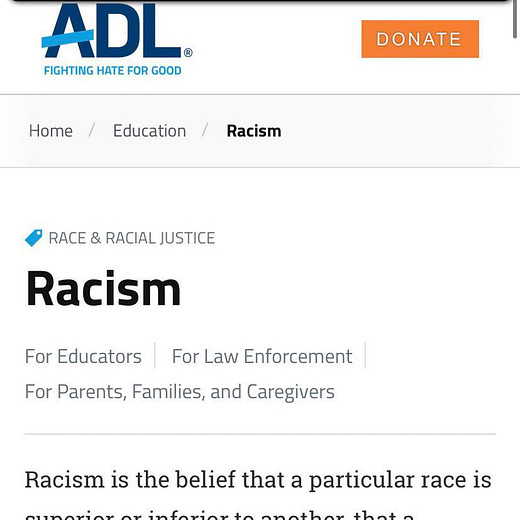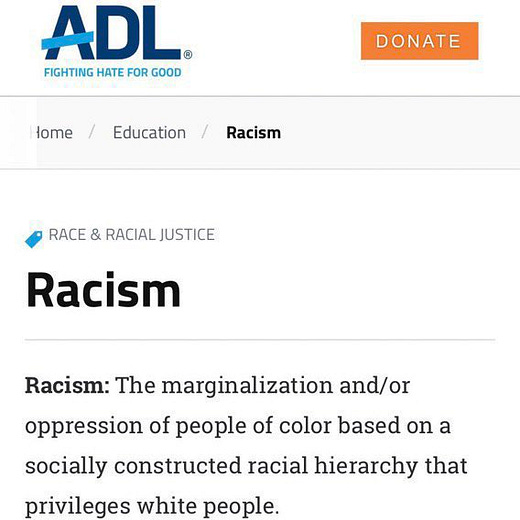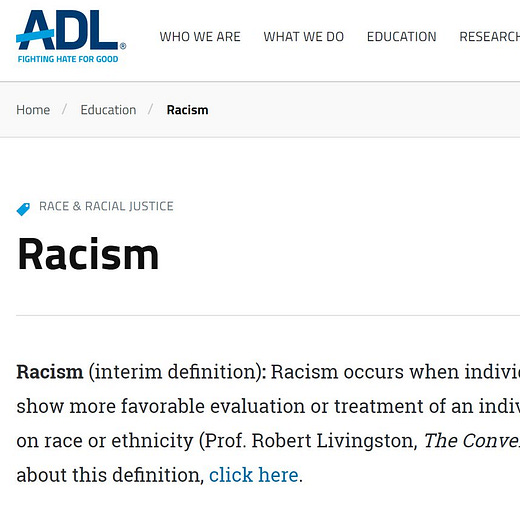On August 26th, 2018, HWFO published a detailed explainer called “The Two Confusing Definitions of Racism,” but as the conversation about racism in the United States continues to devolve, it occurs to me that this wasn’t enough. There are at least five wholly different definitions floating around, each with strict adherents and staunch detractors, different origins, and different motives for use. Some of these are employed by the Woke, some by the UnWoke, and some are universal. And nobody can even begin to have a discussion about racism without first establishing what they’re talking about, because they’re all different. Herein, we will do all five, with a small amount of commentary to clarify who uses each and why.
Definitions
Racism (1): Individual racial prejudice
If I as a white man refuse to go to a black dentist, that’s racist. This is what most of the country thinks of when they think of the term “racism,” even though the actual dictionary definition is not this.
Racism (2): Prejudice Plus Power
This is the common Woke definition, and it stems largely from blending some stuff feminist academic Patricia Bivol-Pavda cooked up in 1979 with some stuff critical race theory academic Kimberlie Crenshaw cooked up in 1989. It’s complicated, but it works basically like this. Imagine you were so focused on identity politics that you classified everyone you meet by their immutable birth characteristics, including sex and race, and then you decided that each one of those immutable birth characteristics granted everyone you met some amount of innate privilege or marginalization inside society. Then you laid them all out on a grid, decided some are privileged and some are marginalized, and then further decided that individual racial prejudice only actually matters when the privileged do it to the marginalized, because when individual racial prejudice flows the other way there’s no “impact.” That’s Racism (2).
In Racism (2), if I’m white and I refuse to go to a black dentist, that’s racist. But if a black man refused to go to a white dentist that would not be racist, because he’s marginalized and the dentist is privileged on Crenshaw’s matrix. But then you need a “totem pole of oppression” style ranking system to figure out whether a black man refusing to go to an Asian dentist is racist, or visa versa. And if you have a white anti-Semite who hates Jews in the USA, he’s racist, but if he moves to Israel he suddenly becomes antiracist because the Jews are in charge there.
The reason the Woke use this definition is because it allows them to use individual racial prejudice against the perceived dominant group as a tool for racial equity, and also because it allows them to recruit prejudiced people into their fold, provided they’re prejudiced against whites.
Racism (3): A system of socioeconomic factors that, in combination, produce differential racial socioeconomic outcomes even if no single element in that system is intrinsically racist.
This is sometimes referred to as “systemic racism,” but sometimes the word “systemic racism” means something different, as detailed below. Racism (3) is one of the most easily identified versions of the word, and examples abound. Redlining, the process of refusing to give mortgage loans to people who live in certain areas due to their bad credit, was systemically racist even though it didn’t attack black people directly. Tuning artificial intelligence algorithms to screen resumes can be systemically racist, even though the computer literally has no concept of what race even is. HWFO did a very deep explainer about how New York City gun control laws are systemically racist, because they led directly to the “stop and frisk” policy, even though no link in the chain that led to that policy was explicitly racist.
Racism (4): The universal and not directly measurable impact that society wide subconscious individual racial prejudice has against a racial group at a population level.
The Woke also call Racism (4) “systemic racism,” and they point to the fact that society has differential racial outcomes as proof that it exists. But this is circular reasoning, because it’s a self-referential definition, and turns the entire thing into a complicated racial version of begging the question.
Blaming differential racial outcomes on society wide subconscious racial bias can also hide real instances of Racism (3) and prevent people from fixing them, like what happened in New York with stop and frisk. The blowback over stop and frisk was so loud they stopped the specific policy of throwing black males ages 18-24 up against walls, but the gun control laws remained, and are still disproportionately enforced, because only the rich or very well connected can get a gun permit in NYC. And guess which race those folks are?
Racism (4) leads to gaslighting behavior by the Woke, where they claim your subconscious bias prevents you from admitting you have bias. It also leads to a practice we at HWFO like to call “ghostlighting,” which is when someone gaslights you into believing you are responsible for the sins of your ancestors.
Racism (5): The belief that race is fundamentally determinant of human traits and capacities, and that because of this one race may have superior traits than another race
This is actually the dictionary definition, which is hard to believe in the modern racism discussion because it almost never comes up anymore. The reason it never comes up is that (A) racism is understood to be universally bad, but (B) it is fundamentally true that there are different statistical distributions of different traits between races, and that many of those traits are absolutely genetic, such as height for instance. And when you have a true thing that is true, but it is universally bad to talk about, nobody talks about it.
Analysis
The racism discussion in the USA is torturously confusing because we have five very different meanings for the same word, not everyone knows the five different meanings, and sometimes bad faith actors hot-swap these definitions in the middle of discussions without letting their opposite interlocutor know they’ve done the swap.
Even the recent Whoopie Goldberg kerfuffle that earned her a two-week stint in the cancel culture penalty box goes back to these definition semantics. The dialogue:
Whoopie: “Let’s be truthful about it because Holocaust isn’t about race,” Goldberg said on The View. “It’s not about race. It’s not about race. It’s about man’s inhumanity to man.”
Ana Navarro: “But it’s about white supremacists going after Jews.”
Whoopie: “But these are two white groups of people! The minute you turn it into race it goes down this alley. Let’s talk about it for what it is. It’s how people treat each other. It doesn’t matter if you’re Black or white, Jews, it’s each other.”
The Nazis were Racist (5) and classified the Jews as an inferior race. Ana was speaking in terms of Racism (1), where individual racial prejudice is bad behavior. And Whoopie responded in Racism (2), that since both of these classifications were privileged (in her mental formulation of the Crenshaw matrix) that it wasn’t racism, it was just white on white violence. Almost every argument about racism I can recall comes down to people talking past each other because they’re operating off of different definitions of the term.
Not even the ADL can seem to get this right. And if you can’t agree on a term’s meaning, you’re speaking different languages.






Great writeup. This is similar to an idea I've had kicking around my head for a while now, about what I want to call "The White Supremacy Spectrum".
Let's imagine that we have a linear ordering of different levels of attitudes/beliefs that one might call "white supremacy". The lowest end of "the least amount of white supremacy possible" would be a white person who argues that white people are, in fact, completely inferior to all other races and it is every white person's bounden duty to give as much of the wealth and power that they have stolen to non-white races as possible. On the highest end, a.k.a. "actual white supremacists", you'd have a card-carrying KKK member who believes in the absolute superiority of the white race over all other races and pretty much every horrible policy proposal that would flow downstream from that belief, e.g. forced segregation/apartheid.
The problem is that, as far as I can tell, there are a whole bunch of different levels in between those extremes, but if the two opposite ends of the spectrum I described are levels 1 and 10, most people in this country are somewhere between levels 4 and 6, and the people at level 4 are calling the people at level 6 "white supremacists" (and by so doing, they intend to evoke the same kinds of disgust and hatred that people rightly feel for the folks at level 10, when the worst thing people at level 6 are guilty of is thinking that the fact that most people tend to live in neighborhoods where the majority of the folks around them look the same as they do is just natural human behavior and not evidence of America being racist to the core.
I keep wanting to work up a description of the full spectrum but haven't found the time.
Thanks for writing.
It struck me that the utility of your analysis lies in demonstrating the utter inanity of the 'conversation' about 'racism' in popular culture. More apt would be the descriptor 'self-important screeching and hooting' about 'media-entertainment industry infighting.' And if this isn't ridiculous enough: given the speed of multiplication, might there not be more definitions soon?
You've written about the two, and now the five; I eagerly await your writeup on the Eleven Definitions of Racism, on which a national conversation will be fanned by the ADL but also by PETA, CDC, and Santa Claus.
What do we do?
My proposal is that we create a unifying common enemy to direct our attention and efforts. Suitable candidates include potentially hostile aliens, or perhaps Belgians